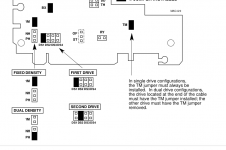Nelson Ogden
Member
Hi Folks,
I have a Pentium II system with a 3.5" floppy (drive A) and 5.25" floppy (drive B) connected to the onboard FDC controller. Motherboard uses a Dallas DS12B887 RTC which I just had to modify with an external battery. After I replaced the battery, I loaded default BIOS settings and went through all the settings, changing what needed to be changed.
That process went fine, but now the BIOS is giving me a "Floppy Disc(s) Fail (40)" error. The error message seems to be related to drive B, a 1.2MB 5.25" Panasonic JU-475-4. If I disconnect that drive, the system boots fine. If I set the drive in the BIOS to 360kB instead of 1.2MB, it boots fine (though the drive won't read 1.2MB disks in Windows). I'm sure this is a 1.2MB drive, but I get the error when I set the BIOS accordingly. Before the battery failed, this system (including the 5.25" drive) worked fine.
If I continue booting after bypassing the error message, the drive "kind of" works. Windows recognizes it and can tell me how much space is used/available on a disk. It can't read the disk, though.
Only thing that changed between the time it last worked and now is the Dallas RTC battery failing so I assume its a BIOS setting somewhere I'm missing. This is a PC I built from spare parts a while back and don't recall having to change any unusual BIOS settings back when I put this PC together. Any suggestions?
I have a Pentium II system with a 3.5" floppy (drive A) and 5.25" floppy (drive B) connected to the onboard FDC controller. Motherboard uses a Dallas DS12B887 RTC which I just had to modify with an external battery. After I replaced the battery, I loaded default BIOS settings and went through all the settings, changing what needed to be changed.
That process went fine, but now the BIOS is giving me a "Floppy Disc(s) Fail (40)" error. The error message seems to be related to drive B, a 1.2MB 5.25" Panasonic JU-475-4. If I disconnect that drive, the system boots fine. If I set the drive in the BIOS to 360kB instead of 1.2MB, it boots fine (though the drive won't read 1.2MB disks in Windows). I'm sure this is a 1.2MB drive, but I get the error when I set the BIOS accordingly. Before the battery failed, this system (including the 5.25" drive) worked fine.
If I continue booting after bypassing the error message, the drive "kind of" works. Windows recognizes it and can tell me how much space is used/available on a disk. It can't read the disk, though.
Only thing that changed between the time it last worked and now is the Dallas RTC battery failing so I assume its a BIOS setting somewhere I'm missing. This is a PC I built from spare parts a while back and don't recall having to change any unusual BIOS settings back when I put this PC together. Any suggestions?

